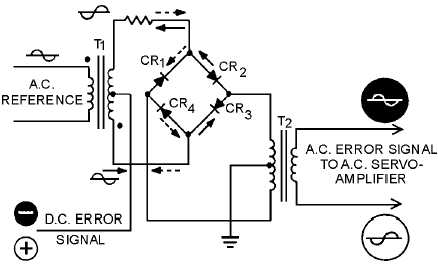2-24
under these conditions because of the 180º phase reversal across T1. Current flow during the positive and
negative half-cycles is represented by dotted arrows and solid arrows, respectively. Suppose a positive, dc
error signal is applied during the negative-going ac input half-cycle at the primary of T1. Current will flow
from ground, through the upper half of the primary winding of transformer T2, through diode CR2, and
through the upper half of the secondary winding of transformer T1 to the dc source. This produces a
positive-going voltage (error signal) across the secondary of T
2
(the first half-cycle of the output signal).
Figure 2-17.—Crystal diode modulator.
On the positive-going ac input reference voltage half-cycle, current will flow from ground, through
the lower half of the primary of transformer T2, through diode CR4, and through transformer T1 to the dc
error signal source. This produces a negative-going voltage (error signal) across the secondary of T
2
(completing the cycle of the ac input reference). Notice that the error signal is 180º out of phase with the
reference signal.
If a negative dc error signal is applied to the modulator, under the same conditions of ac reference
signal, current flow through the circuit will be reversed. Keep in mind that this occurs, for example, when
the load approaches the desired position from an opposite direction. This circuit will work with either a
positive or a negative dc input signal, but only one condition will exist at any given time.
With a negative dc error applied, current will flow from the dc error signal source through diodes
CR3 and CR
1
(on different half-cycles of the ac reference) to ground. This causes an ac voltage to be
produced across the secondary of T2 in the same manner as previously described with the positive dc error
signal input.
The only difference is that current will flow through the upper and lower halves of T2 in a different
direction (toward ground) and cause the output to be in phase with the ac reference signal.
In summary, the modulator produced an ac output, either in phase or 180º out of phase with the ac
reference signal, depending upon the polarity of the dc input signal. The amplitude of the output will be
proportional to the dc input signal amplitude and at the frequency of the ac reference voltage.
Q-22. What is the purpose of a modulator in a servo system?

